| Introducing the Cichlids... |
| Introducing the Cichlids... |
What is a Cichlid?
A freshwater angelfish is a cichlid 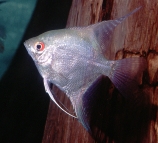
A cichlid [pronounced sick-lid] is a fish in the Family Cichlidae. This is an immense family of freshwater fishes of almost unbelievable diversity. Conservative estimates of the number of species of cichlids range from 1300 to many, many more. Many people have seen a cichlid without even knowing it: oscars and freshwater angelfish, both common aquarium fishes, are cichlids.
What is NOT a cichlid?
Lots of fishes are not cichlids. All cichlids are freshwater fish (though a few are occasionally found in brackish water and rarely in coastal marine areas). There are lots of marine fish that look like cichlids but are not cichlids. There are also tons of other freshwater fish that are not cichlids. Keep in mind that the Cichlidae is just one of 482 families of fishes. There are over 25,000 species of fishes all together, which incidentally is more than all the birds, mammals, reptiles and amphibians combined.
The Arrowana is a freshwater predator, but not a cichlid 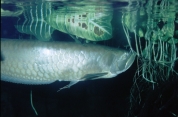
The piranha is another freshwater predator, but not a cichlid 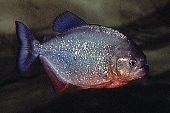
The marine fish, Lutjanus kasmira, a snapper, is not a cichlid 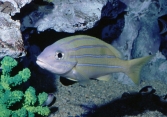
Evolutionary Relationshps
How do the cichlids fit into the 25,000 species of living fishes? For a detailed look at the classification of fishes, click here. In a nutshell, living fishes can be broken down into 5 classes, the largest of which is called the Actinopterygii, or bony-finned fishes. Other classes include things like hagfish (Class Myxini) and sharks (Class Chondrichthyes). Humans and all other land vertebrates are actually fishes falling into Class Sarcopterygii, or lobe-finned fishes, though we don't usually include the numbers of land vertebrates in the count of fishes.
Of the 57 orders of fishes, 42 of these are Actinopterygians. These include all sorts of fishes including sturgeons and gars, eels, herrings, minnows, catfish, pike, smelt, salmon, cod, anglerfish, livebearers, sculpins, perch-like fish and flatfish. This is a huge group of organisms comprising over 23,000 species.
Within this bounty of diversity there is one order that has exceeded all others in generating new and different forms, and this is the order Perciformes, or perch-like fishes. The perciform fishes (Order #55 according to Nelson 1994) contains 148 families in almost 1500 genera, encompassing almost 10,000 species.
One of those families is the Cichlidae. The cichlids make up a disproportionate number of the Perciform fishes, ranking second in number only to the gobies (Gobiidae). Other large families of perciform fishes include the wrasses (Labridae), sea basses (Serranidae), blennies (Blenniidae), damselfishes (Pomacentridae), drums and croakers (Sciaenidae) and cardinalfishes (Apogonidae) all of which have more than 200 species apiece.
Ichthyologists do not yet fully understand all the complex relationships within the Perciformes; however, it seems relatively certain that the Cichlidae belong in a cluster of closely related families which includes the wrasses (Labridae), the damselfishes (Pomacentridae) and the surfperches (Embiotocidae). This cluster is called the suborder Labrodei.
The Suborder Labroidei 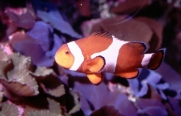
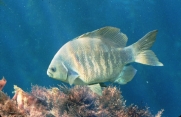
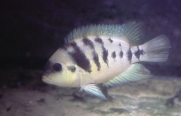
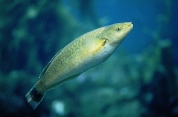
A clownfish; family Pomacentridae A surfperch; family Embiotocidae A cichlid; family Cichlidae A wrasse; family Labridae
Diversity
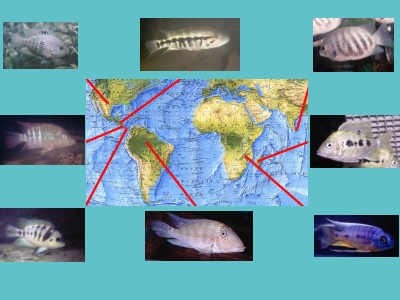
Cichlids come in a surprising diversity of shapes, sizes and colours. They share a few common characteristics, including life in freshwater and advanced forms of parental care of their young. These characteristics do not define the cichlids, because many other fishes also have these characteristics and yet are not cichlids, but they do explain part of the immense popularity of these fishes for aquarists.
Geographic Distribution -- Cichlids are found in the New World from southern Texas down to Argentina in South America. They are found throughout Africa and parts of the Middle East. There are cichlids on the Island of Madagascar, on the Island of Sri Lanka, and along the southern coast of India. There are no cichlids native to the Far East or Australia, nor are any found naturally in North America north of Texas. However, cichlids, particularly the genus Tilapia, have been introduced either deliberately or accidentally into many locations around the world where they were not found natively. For instance, there are many introduced cichlids in the waterways and canals of southern Florida.
Cichlids are found in the New World and the Old World 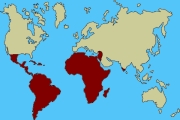
Paratilapia polleni male, a Madagascan cichlid 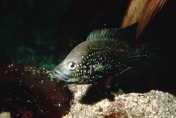
In the aquarium hobby, cichlids are often classified as either "New World" or "African". I think this does a great disservice because the differences between various New World cichlids are as great as the differences between New World and African cichlids. Similarly, many African cichlids are radically different from other African cichlids and a beginner might easily be misled into thinking that just because a cichlid comes from Africa tells you something about how it lives, what it eats, how to keep it in an aquarium, etc. This is simply not true.
Habitat Distribution -- Cichlids are found in almost every possible body of freshwater within their geographic range including rivers and lakes, swamps and even ditches and puddles. They are not found at high elevations and generally require water warmer than about 68oF (20oC).
The Rio Puerto Viejo, in Costa Rica 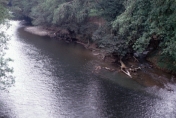
Diversity of Size and Form -- There are large predatory cichlids like the peacock bass (Cichla ocellarus) of South America and there are tiny secretive cichlids (often called "dwarfs") found in many places, including the kribensis group from West Africa (e.g., Pelvicachromis pulcher) and the genus Apistogramma from South America. There are herbivores (plant-eaters) like the mbuna of Lake Malawi and there are carnivores, like the slender pike-cichlids of the Amazon.
A peacock bass, Cichla ocellaris 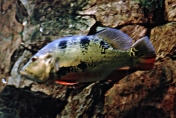
Diversity of Parental Care -- All cichlids provide parental care in one form or another. This is not the norm for fishes -- most fish species do not provide parental care, and of those that do, it is typically the male that provides the parental care (in contrast to mammals or birds where the female is often the primary care-giver). But in cichlids, almost anything can and does happen and that is one of the most fascinating aspects of their biology.
Some species are substrate-spawners, meaning that they lay their eggs on the ground or on a hard surface like the leaf of a plant or on a log. Parental care then consists of guarding the eggs, fanning them to provide oxygenated water, then caring for the hatchlings (called wrigglers) which eventually become free swimming fry. Cichlids are often devoted parents and the length of parental care may extend for weeks or even months.
Most substrate spawners are biparental, meaning both parents take care of the kids, though their exact roles may vary (this is one of the topics I do research on). A few are uniparental with only one parent taking care of the kids.
Some cichlids are haremic (e.g., some of the Apistogramma) were each female lays her eggs in her own cave in the territory of a male, but there may be several females within this male's territory. Each female provides care for her own young, whereas the male protects the entire territory from other males and predators.
There is an interesting variation on substrate spawning seen particularly in Lake Tanganyika -- the shell dwellers. Shell dwellers lay their eggs in the confines of an unused snail shell. This affords great protection to the offspring because a parent can sit in the mouth of the shell and block any predators. Sometimes the shell is so small that only the female can get into it and the male remains permanently outside on patrol. In such cases the male may be much larger than the female and may have many females in his territory, each with her own shell.
Tilapia esculentas female holding eggs 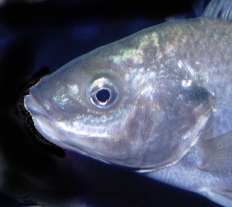
Many species of cichlids, particularly those in Lake Malawi and Lake Victoria, and some in Lake Tanganyika are mouthbrooders. Mouthbrooding is amazing. It is not restricted to cichlids (a number of other families have evolved it independently), but it is nonetheless an incredible thing to see. In these species, a female lays her eggs but rather than sticking them to the substrate, she picks them up in her mouth. The male fertilizes them in her mouth and the eggs remain there, sometimes to hatching, and sometimes well-beyond.
Mouthbrooding is not only found in females in cichlids. Some species are female mouthbrooders, others are biparental mouthbrooders and a few are male mouthbrooders.
Even within the mouthbrooders, there are different types. In some South American species, there is a mixture of substrate spawning and mouthbrooding. We call these delayed mouthbrooders: they lay the eggs on the substrate, guard them for a while, and then pick up the young and mouthbrood them. To distinguish delayed mouthbrooders from species which pick up the eggs right after spawning, we call the latter immediate mouthbrooders.
There are no live-bearing cichlids, though there are a number of other fish families which give birth to live young.
Keeping Cichlids
The popularity of cichlids among aquarists likely stems from three things: many are easy to keep, there are so many kinds and they do interesting things. With few exceptions cichlids can be kept and bred in aquaria. Hundreds of species are currently available in the hobby and many can be kept with a minimum of equipment in aquaria ranging from 10 gallons on up. Some require specialized care and are not for the beginner, but many others are easy to keep and breed. All cichlids provide some form of parental care, meaning that one or both parents tend to the eggs and/or young after laying. Cichlids are devoted parents and watching a pair of cichlids doing their thing is hard to beat.
For more information
For a selection of books, magazines and videos that provide much more information, click here.
![[Go Back to Contents]](gifs/back.gif) |
![[Send email to Ron Coleman]](gifs/address.gif) |